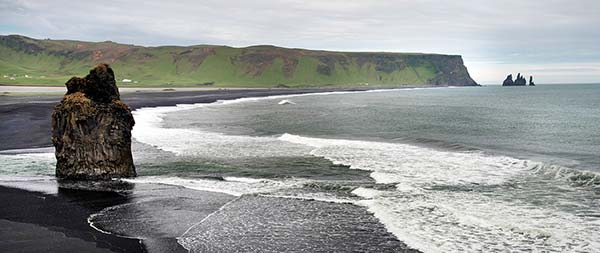
FROM REYKJAVÍK TO SELJALANDSFOSS
SLEEPING AND EATING IN ÞÓRSMÖRK
To bask in a land of mountains, glaciers, and rugged coastal scenery, head for Iceland’s South Coast. Within about a 2.5-hour drive of Reykjavík, you’ll find black sand beaches, dramatic promontories, gushing waterfalls, glacial tongues just finishing their slow-motion 500-year journey, museums on folk culture and volcanoes, and rolling green farm fields dotted with sheep, cows, and Icelandic horses.
All of this sits in the shadow of two glacier-topped volcanoes: Eyjafjallajökull and the even more powerful Katla. The towns here are humble, with sparse sights and services, but Vík—at the far end of this day’s drive—has a beautiful setting.
The South Coast rivals the Golden Circle as Reykjavík’s best side-trip: It’s arguably even better for outdoorsy types, offering more nature activities and a top hiking destination, the mountain ridge called Þórsmörk. However, unlike the Golden Circle, you’ll head home the way you came—making the scenery a rerun.
As a Day Trip: You can do the South Coast on your own—following the driving tour outlined in this chapter—or with a bus excursion in a single long day (about 10 hours) from Reykjavík. Various companies offer full-day guided excursions year-round (prices range from about 13,000 ISK to 19,000 ISK based on the group size; see the Near Reykjavík chapter for a list of tour companies). These don’t pack in as many stops as this chapter outlines, but some tours offer the option of adding on a glacier hike or other activities.
As an Overnight: While most people visiting this area are day-tripping from Reykjavík, the South Coast can also be used as a home base (see recommendations later in this chapter, under “Sleeping on the South Coast”). For instance, if doing the long, clockwise Ring Road route, you could make the South Coast your final overnight, as it’s the ending point of that drive. Or you could do the Golden Circle drive from Reykjavík, but instead of looping back to the city, end that drive here on the South Coast, where you can spend a night or two (from here, you can head straight to Keflavík Airport for your departure flight, without returning to Reykjavík).
Spending two full days here opens up several sightseeing options. For example, if the weather’s good, you can day-trip by boat from Landeyjahöfn to the Westman Islands (see that chapter). Or you can devote a day to the trails at Þórsmörk, which presides over a volcano-ringed glacial valley (described later in this chapter). Accessible only via specially equipped 4x4s or public buses equipped with monster-truck tires, Þórsmörk rewards hikers with stunning, panoramic views over cut-glass peaks and ruddy valleys.
This self-guided driving tour links up the main attractions along the South Coast, in the order you’ll reach them from Reykjavík. (Those ending their clockwise Ring Road drive will see these sights in the opposite order. Just hold the book upside down.) It’s about a 2.5-hour drive each way between Reykjavík and the far point of this area, the town of Vík. Adding in time for a few necessary side roads, plan on at least six hours behind the wheel, plus about five hours to visit sights along the way. Figure on about 11 hours for the full experience.
The basic plan: From Reykjavík, make good time on highway 1 across the desolate Hellisheiði plateau, then through the towns of Hveragerði, Selfoss, Hella, and Hvolsvöllur (where the Lava Centre is worth a visit on the return drive). Just beyond—1.5 hours after leaving the capital—you’ll cross the river called Markárfljót and enter the most striking part of the drive. The stops along this stretch are captivatingly Icelandic: Hike behind the thundering Seljalandsfoss waterfall, ogle the glacier-capped volcano called Eyjafjallajökull, and pause in Skógar to see another towering waterfall and a good folk museum. Next, hike up close to the chilly tongue of Sólheimajökull glacier, enjoy the views from the Dyrhólaey promontory, and stroll along the black sand beaches at Reynisfjara. Just beyond those sights, the village of Vík has a big gas station and restaurants, offering a good pit stop before starting the 2.5-hour return drive back to Reykjavík.
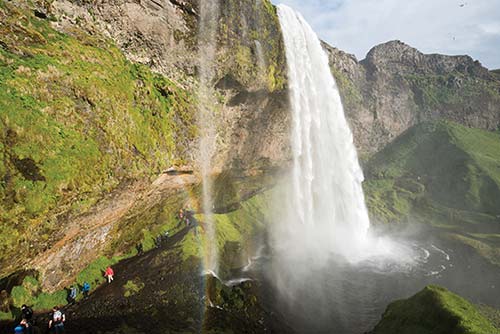
This plan is designed to efficiently link the highlights of Iceland’s South Coast:
| 9:00 | Leave Reykjavík and head for your first stop: the Seljalandsfoss waterfall (1.75 hours) |
| 10:45 | Visit Seljalandsfoss waterfall |
| 11:15 | Drive to Skógar (30 minutes) to visit the waterfall and folk museum, and have lunch |
| 14:00 | Head for Sólheimajökull (15 minutes from Skógar) to see a glacier |
| 15:15 | Drive to Dyrhólaey promontory (15 minutes); with time and energy, hike to the lighthouse |
| 16:00 | Depart for Reynisfjara (25 minutes) and walk the black sand beach |
| 17:00 | Start the drive back toward Reykjavík, stopping in Hvolsvöllur (1 hour) |
| 18:00 | Tour the Lava Centre in Hvolsvöllur (open until 19:00) |
| 19:00 | Drive back to Reykjavík (1.5 hours), and consider stopping for dinner en route |
There are a number of adjustments you can make to this suggested plan. Consider the following:
With Less Time: To make it a shorter day, skip the Skógar Folk Museum and Dyrhólaey.
With More Time: If you’re willing to leave earlier or get back later, your day will be more leisurely. For example, rather than driving straight through and dining late in Reykjavík, you could enjoy a countryside dinner on your way back (for ideas, see “From Vík Back to Reykjavík,” at the end of the drive).
If overnighting on the South Coast, you can add more sights: Stop at the visitor center of the Hellisheiðarvirkjun geothermal power plant, check out Bobby Fischer’s grave, see the Gljúfrabúi waterfall, visit the Eyjafjallajökull exhibition, or spend time in the village of Vík.
Hiking at Þórsmörk: The mountain valley of Þórsmörk is a hiker’s delight, but it takes the better part of a day to experience. You can either do it as a long day trip from Reykjavík, or, if sleeping along the South Coast, you can catch a bus from Hvolsvöllur.
Weather Warnings: Visiting waterfalls and glaciers can be cold and wet; dress warmly and bring waterproof clothing and footwear. Also, be aware of the risk of blowing sand (which can damage your rental car’s finish, at your expense). There is a small sandy patch (just a few hundred yards long) at the bridge where highway 1 crosses the Markárfljót river, just before the Seljalandsfoss waterfall. Check the weather before you go (at en.vedur.is) and consider alternative plans if very high winds are forecast. For more information see “Driving Hazards” in the Practicalities chapter.

Once you’ve left Reykjavík, it’s less than a two-hour drive east along highway 1 to the Seljalandsfoss waterfall. Along the way, you’ll pass some functional towns—Hveragerði, Selfoss, Hella, and Hvolsvöllur—which have a few minor sights not worth going out of your way for. The one exception is the excellent Lava Centre in Hvolsvöllur, the only place between here and Seljalandsfoss that’s definitely worth a stop. You could see it on your way out, or save it for your return drive.
• Just a few minutes after leaving Reykjavík’s suburban sprawl on highway 1, you’ll find yourself at...
The 1,200-foot pass called Hellisheiði is a starkly desolate volcanic landscape, where you could easily encounter bad weather in April or October. If you have time, consider a stop at the Hellisheiðarvirkjun geothermal power plant, with an exhibit on geothermal energy (see here).
Soon after the plant, you reach the edge of the plateau and drop down on a switchback road. In good weather, you’ll enjoy great views over the southern lowlands. Below you is the town of Hveragerði, at the head of an evocative valley misty with steam vents. (The town’s name, aptly, means “hot spring enclosure.”) The top end of this valley is where intrepid bathers can hike an hour up to the thermal river at Reykjadalur. For a description of the thermal area, see the end of the Golden Circle chapter.)
• About 10 minutes past Hveragerði, you’ll reach the large town of Selfoss (population 7,000), with a full range of services. If you don’t want to stop, stay on highway 1, which crosses a river and then heads east as it skirts the northern edge of Selfoss (keep left at the main roundabout, following signs toward Vík and Hella).
But if you’re intrigued by American chess grandmaster Bobby Fischer, you may want to consider a brief detour to see his grave. At the east end of Selfoss (the far end, if coming from Reykjavík), a sign for Laugardælakirkja points north along a side road. Turning off here and driving less than a mile brings you to a small church at the Laugardælur farm (you’ll practically drive through the farmyard).
American chess champion Bobby Fischer was buried here after his death in Iceland in 2008. His gravestone is easy to find, just inside the churchyard gate. When the eccentric, reclusive Fischer came to Iceland in 1972 to face Russian grandmaster Boris Spassky for the world chess championship, he struck up a friendship with Sæmundur Pálsson, the policeman assigned to chauffeur him around. In 2004, Fischer landed in prison in Japan and was due to be extradited to the US on tax evasion charges. (He was in trouble with the IRS for playing chess in Serbia during the Yugoslav wars.) Sæmundur and a small group of friends arranged for the Icelandic parliament to grant Fischer citizenship and chartered a plane to pick him up in Japan. They brought him to Reykjavík, where he lived quietly until his death. This basically merciful act eased the last years of an ill and elderly man. Some think that the American government silently condoned the operation to avoid the discomfort of putting Fischer on trial.
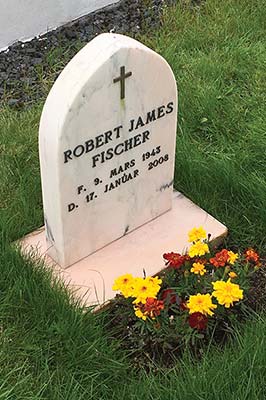
If you’re interested in seeing Fischer memorabilia, visit the tiny information center about him on the main street in Selfoss (1,000 ISK, daily 13:00-16:00, closed mid-Sept-mid-May, Austurvegur 21, mobile 894-1275, www.fischersetur.is).
• From Selfoss, follow highway 1 east across a lush plain, eventually passing through two small towns, Hella and Hvolsvöllur (KVOLS-vurt-lur). Each town has about 1,000 people, a grocery store, a couple of places to eat, a thermal swimming pool, and gas stations with WCs (you’ll also find several recommended accommodations nearby). Right along the main road through Hvolsvöllur is the...
This state-of-the-art attraction rivals the excellent Volcano Museum in the Westman Islands, and uses cutting-edge exhibits to explain Iceland’s volcanic heritage. It’s well-presented and enjoyable for all ages and interest levels—worth the pricey ticket. As it’s open fairly late, consider stopping here on your way back to Reykjavík.
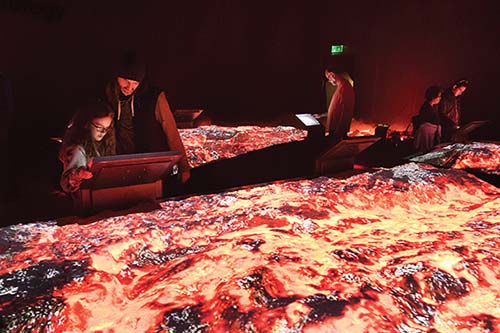
Cost and Hours: 2,200 ISK, 700 ISK extra for 12-minute film, daily 9:00-19:00, can’t miss it along the main highway 1 at the western edge of Hvolsvöllur, tel. 415-5200, www.lavacentre.is.
Eating: The Lava Centre has a $ café (with an affordable soup buffet, and takeaway salads and sandwiches) and a cafeteria-style $$ restaurant. You can eat here even if you’re not visiting the museum (both open until 21:00—later than the exhibit).
Visiting the Museum: In the free-to-enter lobby, you’ll find a large virtual map of Iceland identifying minor earthquakes over the last 48 hours. Smaller screens let you watch eyewitness accounts of various eruptions. Check out the cross-section of soil excavated at this site, striped with ash and tephra deposits from eruptions over time. (The lobby also has free WCs and a branch of the Rammagerðin gift shop with expensive, high-quality Icelandic souvenirs.)
After buying your ticket, head down a long timeline corridor to the interactive exhibit. You’ll see a towering, glowing mantle plume (an underground geyser of lava), and stand over eerie and mesmerizing simulated lava flows on tabletops. Throughout, touchscreens invite you to learn more about volcanoes, and darkened corridors between the rooms add to the experience—with simulated ash clouds, noisy eruptions, and trembling floors. In the “Volcano View” room, you’ll stand in the middle of wrap-around, wall-to-ceiling virtual footage of what eruptions in this area would look like up close.
You can pay extra for the cinema, where a 12-minute film with a booming soundtrack and dramatic music shows off high-definition footage of spitting and flowing lava; historic photos and videos of past eruptions; and aerial eye-candy scenery of volcanic landforms around Iceland.
• From Hvolsvöllur, it’s about a 15-minute drive to the bridge over the Markárfljót river. Directly after the bridge, turn left onto highway 249, and then take the first right into the pay parking area for the Seljalandsfoss waterfall (with a basic café and WCs).
Seljalandsfoss (SELL-yah-lahnds-foss) tumbles over its cliff into a pool, with a cave-like walkway just behind it. The 210-foot-high falls aren’t that powerful—but they are handsome. The water comes from Eyjafjallajökull, the glacier capping the volcano that erupted in 2010. In good weather, a one-way path lets you walk around the back of the waterfall; in icy conditions, skip it (it’s closed off in winter). If you do walk the path, wear a waterproof jacket and shoes—the path is damp and uneven, and you’ll be sprayed steadily.
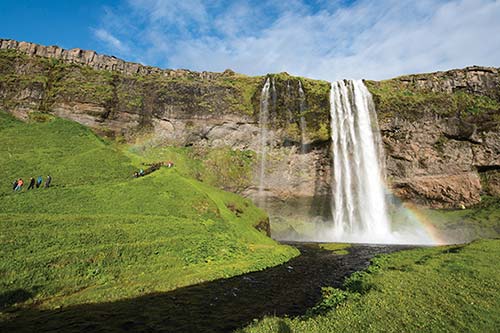
Before starting off, visually trace the entire path around this one-way loop to be sure you’re up for it. The easy part is circling down around behind the cascade. The return trip is the hard part, as it requires climbing up steep rocks and tiptoeing through deceptively deep mud puddles to the top of an old staircase that allows an easy drop down to street level.
Photographers: The sun shines on the falls in the afternoon; in the mornings the mountain shadows them. For the best light, consider visiting in the afternoon, on your way back to Reykjavík.
Optional Add-On: A 30-minute side-trip takes you to another waterfall called Gljúfrabúi (GLYOO-vrah-BOO-ee, literally “Canyon Dweller”). This waterfall, much smaller than Seljalandsfoss, drops into a hollow within the rock and then exits (as a stream) under a tall, narrow, natural archway. To catch a glimpse, walk 10 minutes on the gravel path left of Seljalandsfoss past several minor cascades. From outside, you can only see the very top of the falls. To see a little more, hike up to the archway (on a challenging trail with handholds). To get close to the falls, you have to wade several yards, at your own risk, along the normally shallow but swift-flowing stream as it exits the arch (you’ll want high rubber boots and full rain gear). On a typical day trip from Reykjavík, Gljúfrabúi isn’t really worth it, but nature lovers or those with more time may enjoy it.
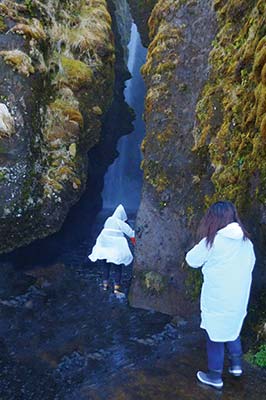
This stretch—less than an hour’s drive without stops—is lined with attractions and detours that can easily fill the rest of your day.
• Leaving Seljalandsfoss, return to highway 1 and continue east. If the coast is clear, look out to sea, where the horizon is fringed with the jagged cliffs of the Westman Islands rising up just offshore. These islands were formed by volcanoes, including a very recent and dramatic eruption in 1973, which consumed a third of the main town’s houses and expanded the island’s size by about 20 percent. Aside from the eruption, the Westman Islands are known among Icelanders for their fishing industry, seabird colonies (including lots of puffins in the summer), and folk music (to visit them, see the Westman Islands chapter). About 15 minutes’ drive beyond Seljalandsfoss you’ll reach the...
Eyjafjallajökull is the name of the glacier that tops the volcanic mountain peak you’re driving under (the mountain itself is called Eyjafjöll). This volcano thrust Iceland onto the world stage for a week in April 2010, as the ash it ejected high into the atmosphere settled over Europe, halting international air travel. For details, see the sidebar.
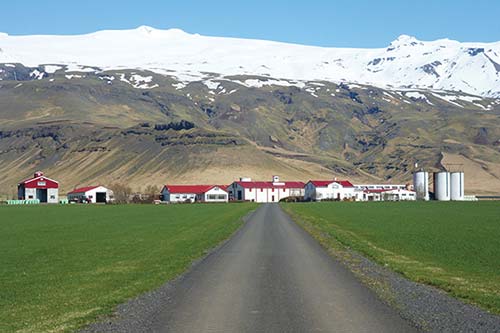
• You’ll soon pass a restaurant, worth considering for lunch.
Eating near Eyjafjallajökull: Located at a roadside farmstead, $$ Gamla Fjósið (“Old Cowshed”) specializes in simple but satisfying dishes made with beef raised right here—delicious steak sandwiches, burgers, and soup. It fills an actual, rustic old cowshed with mismatched furniture under rafters. If you avoid the overpriced fish and seafood dishes, it’s a decent value (daily 11:00-21:00, closed off-season, Hvassafell, tel. 487-7788).
• After passing the restaurant, you’ll reach a large shed on the south side of the road that houses the...
Eyjafjallajökull Erupts Exhibition: Here you’ll find a small room with a poster exhibit and a 20-minute film in English about the 2010 eruption. The film focuses on the experiences of the family at the Þorvaldseyri farm across the road (they run the exhibit). While it pales in comparison to the big, slick Lava Centre up the road in Hvolsvöllur, this exhibit offers a somewhat more intimate look at the eruption, and can brighten up a rainy day (850 ISK; June-Aug daily 9:00-18:00, shorter hours off-season, closed Sat-Sun in winter; tel. 487-5757, www.icelanderupts.is). Just beyond the exhibition, and across the road, look for a pullout with picnic benches and informational plaques (next to the Þorvaldseyri farm’s driveway).
Thermal Bath Detour: From here, hardy bathers can consider a detour to Seljavallalaug, a very rustic thermal swimming pool (from 1923) built right into the side of a mountain slope. Some people enjoy the pool’s scenic and remote location, which requires a 15-minute hike up a desolate valley. Don’t expect a sleek and sanitary experience: The pool is unstaffed and has very limited services (grubby changing rooms), and the water is warm rather than hot. But backpackers and campers looking to take a memorable dip enjoy the detour. (From highway 1, just beyond the exhibition pullout, watch on the left after the bridge for road 242 to Raufarfell, then follow signs for Seljavellir to the end of the road, where you can park and hike.)
• Continuing along highway 1, watch on the left after about four miles for a building embedded into the side of a massive rock at a farm.
Drangshlíð: While I’m not much for Iceland’s “hidden people” legends (see sidebar on next page), this sight is intriguing enough to warrant some fantastical stories. The structures here are cowsheds, and said to be peopled by elves who look after the livestock...and prefer to do it without human interference. According to legends, the farmer would leave hay and an empty milk bucket outside the sheds. And then later, he’d discover that the cows had been fed and milked. As it’s private property, it’s best not to try to visit up close.
• Soon after Drangshlíð, watch on the left for the turnoff to a small settlement called...
Skógar (SKOH-ar, “Woods”) was originally the site of a local district school. There are two main attractions here: the Skógafoss waterfall (which you can’t miss, on your left) and the Skógar Folk Museum (to the right).
This waterfall, on a river that drains down from Eyjafjallajökull, is much broader and more powerful than Seljalandsfoss. And yet, it’s less spectacular, and you can’t walk behind it. Park in the free lot (with pay WC) and gaze up at the water plunging over the side. A stairway climbs all the way up to the top of the falls (about 500 steps); it offers another perspective on the falls and lets you see the river up top. Skip the stairs if you’re in a hurry or just not up for the climb. The stairway is actually the start of a long, popular trail that continues all the way up over the saddle between the Eyjafjallajökull and Mýrdalsjökull glaciers, and over to Þórsmörk (requires good preparation; for more on the Þórsmörk area, see the end of this chapter).
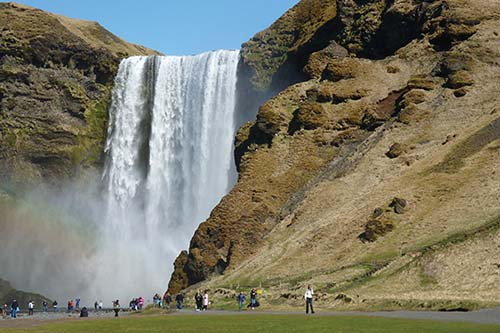
Eating at Skógafoss: $$ Hótel Skógafoss Bistro Bar is the best of a cluster of restaurants near the falls. The dining room and outdoor deck have a nice view, and they have a fine menu of lamb, fish dishes, burgers, and soup (daily 11:00-21:00, until 22:00 in summer, tel. 487-8780).
This large and impressive collection, with both indoor and outdoor areas, is worth the entry price for those who’d like to mix some museum-going into their scenic South Coast day.
Cost and Hours: 2,000 ISK, daily June-Aug 9:00-18:00, Sept-May 10:00-17:00, tel. 487-8845, www.skogasafn.is. The museum has a café (closes one hour before museum), and lets nonguests use the WC for a small fee.
Visiting the Museum: The museum has three sections. The main ticket desk and café are in the biggest building (farthest from the waterfall), along with the museum of Icelandic transport and communications. A one-way route snakes through a huge hall cluttered with artifacts, all described in English. In addition to lots of shined-up old cars and rescue equipment, you’ll wander past neatly arranged piles upon piles of all kinds of devices—like radio transmitters—and entire walls lined with first-generation cell phones.
The smaller, adjacent building is a typical regional history museum. The three floors have old household goods, farm implements, local archaeological finds, an 1855 fishing boat with a photo of its crew, and many other items. Compared to similar museums elsewhere, the sheer volume of stuff here impresses—where other such museums might have one spinning wheel, Skógar has a dozen, all lined up in a row.
Behind the two buildings is a small open-air museum with original buildings that were moved here, including two sod-roofed farmsteads (with stone walls and labyrinthine passages), an old timber house, and a school building—all traditionally furnished. The little church itself is not old—it was built here in the 1990s—but the furnishings inside are original, salvaged from other churches in the region.
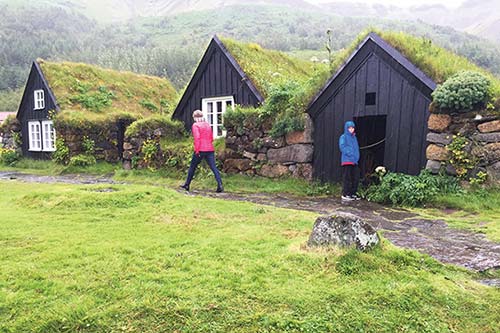
• From Skógar, your next stop is Sólheimajökull, a glacier tongue that spills downhill from the much larger Mýrdalsjökull (skippable if you’ll also be seeing the stunning glacier lagoons—about 2.5 hours farther down highway 1 and described in the Ring Road chapter). To visit the glacier, continue on the main road. Less than 10 minutes past Skógar, look for signs to Sólheimajökull. Turn off the main road, drive for five minutes along paved highway 221, then park in the lot at the end of the road.
Sólheimajökull (SOHL-HAY-ma-YUR-kutl, “Sun-homes Glacier”) is one of Iceland’s most accessible places to get up close to (and, often, actually even touch) a glacier. Allow about an hour for a quick visit.
From the parking lot (pay WCs at the café), walk 15 minutes toward the glacier (dress warmly—it’s colder by the glacier than at the parking lot). At first you walk on a wide, rocky gravel track. You’ll then see a sign telling you not to proceed farther. There are several reasons for this: Melting ice under sand can create a quicksand-like phenomenon, poisonous volcanic gas can be released from under the glacier, ice calving off the glacier can create small tidal waves on the lagoon, rock can slide down the slope, and people can simply slip and fall into the cold lagoon.
Despite these dangers, most visitors choose to keep going, walking across uneven ground to the glacier itself (the helmeted glacier hiking groups that you may see come every day). If you choose to continue past the sign, use common sense, stay near other visitors, and keep in mind that the end of the glacier tongue is always changing, making it impossible to predict the ice and meltwater conditions. In recent years, it’s been easy to walk right up next to the ice and give it a loving pat. But rock falls or rushing streams may force you to stay back and look from a distance.
If you’ve never seen a glacier before, you may be surprised at how dirty it is. Brilliant whites alternate with sections where the surface is covered in black dust. The glacier has been steadily receding over the past few years. You can watch a good time-lapse sequence of its extent at www.extremeicesurvey.org.
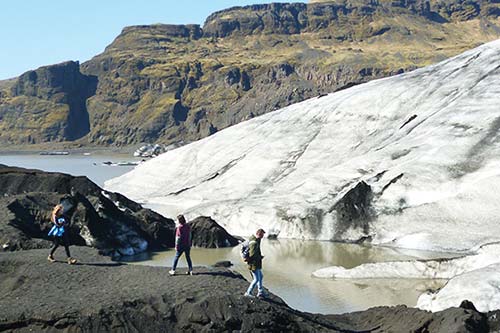
Something else to ponder: A generation ago, the glacier reached all the way to the parking lot (saving visitors a long hike). American politicians may squabble over global climate change, but Icelanders can tell you that there’s no question their glaciers are receding. In western Iceland, the Okjökull glacier receded to the point that it lost its glacier status—now it’s just called “Ok.” That’s not OK.
Hiking on the Glacier: For most visitors, just looking at the glacier is a fine experience. But if you want to climb on it, you should be properly outfitted and in the safety of a group. Many companies have excursions of varying lengths and difficulty that take you up on Sólheimajökull and equip you with an ice ax and crampons (about 25,000 ISK). Some companies offer glacier hikes as a day trip from Reykjavík, but you can also join an excursion on-site (look for sales kiosks in the Sólheimajökull parking lot—but ideally, book a day or two ahead). For excursion companies, see the “Glaciers” section of the Icelandic Experiences chapter.
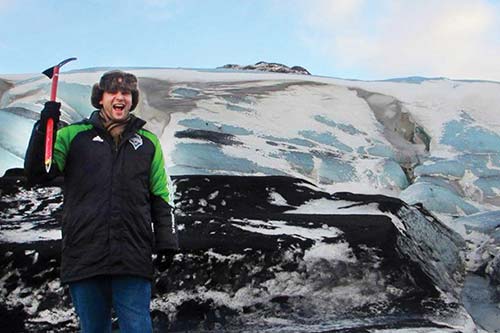
Eating at Sólheimajökull: The little $ Arcanum Glacier Café occupies converted shipping containers next to the parking lot. It has a limited menu, but it’s fine in a pinch (daily 9:30-17:30, tel. 547-1500).
Nearby: You might hear about Sólheimasandur, a desolate beach where you can see the remains of a DC-3 plane that crash-landed in the 1970s (everyone survived). The rusty fuselage lies close to the sea on the sandy wastes near the turnoff to Sólheimajökull. But unless you’re an aviation nut, skip it: It’s a dull 2.5-mile hike each way, there’s nothing to see besides the empty fuselage, and the landowners discourage visitors.
• Return to highway 1 and continue east another 10 minutes, then turn onto highway 218. Drive about five minutes, cross the causeway, then take the left fork. (The right fork heads up the hill to the lighthouse, but regular cars can’t make it up.) You’ll come to a parking lot for...
Dyrhólaey (DEER-hoh-la-AY) is a promontory with a lighthouse, natural sea arches, and picturesque offshore rocks. If you’re in a hurry and won’t have time for the lighthouse hike (about 10 minutes each way), Dyrhólaey is skippable. You’ll get similar scenery at Reynisfjara beach, our next stop at the far end of this same bay.
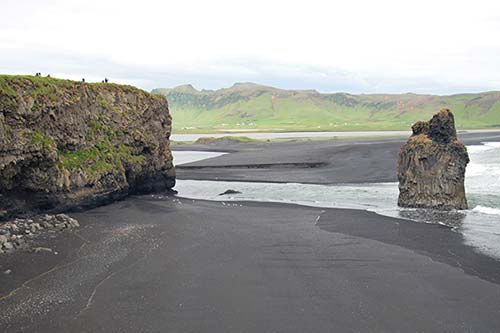
Dyrhólaey (literally “Doorhill Island”) is not really an island, but it’s only barely connected to the mainland by a couple of sandbars and a road causeway. At the parking lot, short paths lead up to several overlooks. Enjoy the sweeping views over black sand beaches, stretching from this perch all the way to Reynisfjara. In the early summer, the cliffs around you teem with seabirds (including, often, puffins)...birders love Dyrhólaey. Obey the warning signs: The beaches below the parking lot are permanently chained off after several tourists were swept out to sea by sneaker waves.
The main payoff for visitors to Dyrhólaey is hiking up along the cliffs about a half-mile to the lighthouse for more views (follow signs). The lighthouse was recently converted into a top-end boutique hotel. Stay back from the cliff edge as you make your way up, as rock falls have taken a few tourists with them over the past several years. It can also be quite windy here.
Note that from early May to late June, part or all of Dyrhólaey may be closed to car traffic (and maybe even to hikers) to protect nesting birds. While they typically keep it open during the daytime (9:00-19:00), it depends on nesting conditions. Even if it’s open, avoid getting too close to nests; Arctic terns aggressively dive-bomb tourists who accidentally wander near their eggs.
• Next up: the black sand beach of Reynisfjara. Return to highway 1 and continue east almost 10 minutes, then turn right onto paved (though potholey) highway 215, following signs for Reynishverfi (the village next to the beach). Along the way you’ll drive through a broad, lush, green farmland delta that feels more Celtic than Icelandic. In the pastures, cows moo contentedly—a relatively rare sight in Iceland, where they’re mostly kept indoors. Another 10 minutes brings you to a big parking lot with pay WCs and a beach café. From the parking lot, it’s just a couple minutes’ walk to...
Tucked under grassy mountains, at the far end of the bay from Dyrhólaey, Reynisfjara (RAY-nis-fyah-rah) is worth ▲▲ on a nice, calm day. The beach here changes frequently with the ocean currents. The sand can bank up higher, or be partially swept away. The tide has an effect, too. In exceptional conditions, a very high tide can flood the parking lot. In winter, all but a thin strip of black sand may be covered by snow.
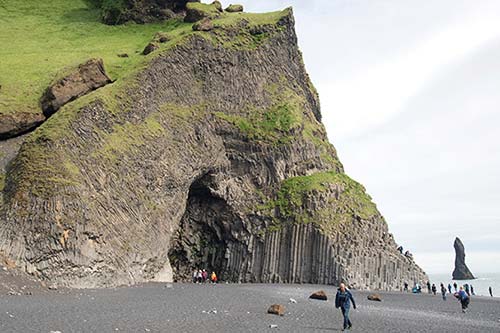
Looking out to sea, on your left you’ll see dramatic basalt formations—splintered columns of volcanic rock, evocative of the famous Giant’s Causeway in Ireland. Kids enjoy scrambling up the uneven stair-steps formed by the splintered rock, and anyone can easily explore the shallow caves formed by the columns.
Just beyond the basalt caves are the jagged Reynisdrangar sea stacks, also formed by volcanic activity. Scanning the horizon to the right, you’ll see all the way to the Dyrhólaey promontory.
Caution: The beach is inviting...but very dangerous. The sea is extremely strong here, with an undertow, and tourists have drowned. Frequent sneaker waves—huge, unexpected surges of water—swamp areas of the beach that looked dry a minute before. It’s fine to walk along the black sands, but stay well back from the water—much farther back than you think is safe—and never turn your back to the sea (not even for a selfie). Make sure that children also understand the rules.
Eating at Reynisfjara: $ Black Beach Café, also known as Svarta Fjaran, is a cafeteria-type place serving simple grill meals. With outdoor seating just off the beach, it’s an inviting spot to nurse a beer (daily June-Aug 11:00-22:00, Sept-May until 18:00, tel. 571-2718, www.blackbeach.is).
• If you’re tired or short on time, head back to Reykjavík now—you’ve seen the best of the South Coast. Otherwise, continue on to one more town to refuel and refresh for the 2.5-hour trip back.
A 10-minute drive over a low pass beyond the Reynisfjara turnoff, Vík (pop. 300, also known as Vík í Mýrdal) is Iceland’s southernmost village and the endpoint of this tour. Vík enjoys a stunning setting—huddled up against a craggy cliff, with green pastures all around and a pointy steeple overlooking the town center from its plateau perch. But the town itself is almost painfully practical, with very little charm. It’s not an inviting place to linger, and most people use it as a turnaround spot for a rest and a bite to eat before returning to Reykjavík.
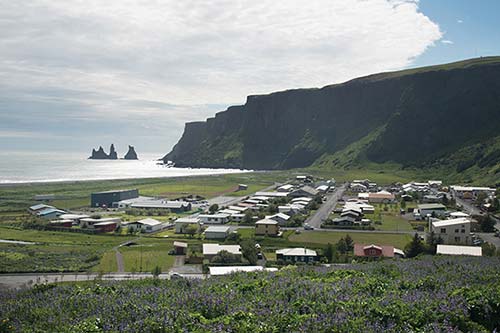
If the weather’s good you can turn off to reach the village church on your way into town (watch for road marked Suðurvíkurvegur on left). While the church itself is as humble as its town, the parking lot around it offers fine views over Vík, the adjacent cliffs, the jagged dragon’s-teeth sea stacks just offshore, and the long stretches of South Coast not covered in this chapter. (If you’re intrigued, sights along the Southeast Coast are covered in the Ring Road chapter.) The recommended Suður-Vík restaurant is near the church.
Continuing into town, turn off the main road onto the street called Víkurbraut (on the right). In the Brydebúð building—an 1831 storefront that was moved here from the Westman Islands—the tiny but crowded TI has a free exhibit on the Katla volcano (irregular hours, Víkurbraut 28, tel. 487-1395).
Across the street from the TI is the little Skaftfellingur Museum, a warehouse displaying the rickety remains of a beloved local ship. The Skaftfellingur was built in 1918, went into service during World War II, and was decommissioned in 1963. The museum works hard to spin nostalgic stories about Vík’s town heritage. One exhibit identifies the many shipwrecks that have occurred in the treacherous waters off Iceland’s South Coast (500 ISK, June-Sept daily 10:00-18:00, shorter hours off-season).
There’s little point in perusing the real estate ads here. Vík is directly below Mýrdalsjökull and the Katla volcano, which is due for another eruption. If the volcano erupts, melting water will rush down the slopes, creating a massive, downhill tidal wave that will deluge everything from Sólheimajökull glacier to well past the town of Vík; those present might have only a few minutes to evacuate. The village church, high on a hill, is supposed to be the safest point.
Eating in Vík: $ Halldórskaffi, a busy, convivial café that shares the Brydebúð building with the TI, serves reasonably priced meals (daily 12:00-21:00, tel. 487-1202). $$ Suður-Vík, up the road near the church (go left at the fork), offers slightly finer dining in a fun, cheery, attic-like space, with fine views over the town and cliffs from the deck. While their à la carte menu is pricey, they also offer cheaper pizzas (daily 12:00-21:00, Suðurvíkurvegur 1, tel. 487-1515). The N1 gas station on the main road at the east end of town has a cheap, grubby roadside grill called $ Víkurskáli, which serves up burgers and deep-fried fish (daily 11:00-21:00).
It’s about 2.5 hours—back the way you came on highway 1—to return to the capital. Along the way, consider dinner at one of these restaurants (listed in the order you’ll reach them as you drive back):
In the Eyjafjallajökull Area: Gamla Fjósið is a good place to stop for burgers and other beef dishes.
In Hvolsvöllur: If you’re stopping at the Lava Centre on the way home, it’s easy to grab a basic bite in their café/restaurant.
Lobster Detour near Selfoss: These places, about 15 minutes south of Selfoss, highlight humar (a.k.a. langoustine or Norway lobster). In Selfoss, head south on highway 34 (at the main roundabout, turn off for Þorlákshöfn, Eyrarbakki, and Stokkseyri). When you hit the coast, turn east on highway 33, to the village of Stokkseyri. Overlooking the water, $$$$ Fjöruborðið (“The Water’s Edge”) is a venerable, nautical-themed lobster house with simple but good dishes. It’s not cheap—a meal-sized bowl of lobster soup is 3,500 ISK, or you can pay (dearly) by weight for a sizzling skillet of humar tails. But it’s a memorable way to sample this coastal delicacy. There’s no view despite its waterside location (daily 12:00-22:00, reservations recommended, Eyrarbraut 3a, tel. 483-1550, www.fjorubordid.is).
Another humar-focused restaurant is $$$ Hafið Bláa (“The Blue Sea”), perched scenically on a ridge by the beach and also about 15 minutes from Selfoss. The food is slightly cheaper than at Fjöruborðið, with more non-lobster dishes. And while it’s not as well-regarded, the setting is far more striking: From the airy, modern dining room, you look north into the delta of the Ölfusá river, and south over crashing waves and a black sand beach that’s good for a stroll before or after dinner (daily 12:00-22:00, Óseyrartangi at the Ölfusá Bridge, 816 Ölfus—follow directions above, but keep going on highway 34 rather than turning off on highway 33, tel. 483-1000, www.hafidblaa.is). From this area, it’s less than an hour’s drive back to Reykjavík (hop on highway 33/34 west, then north on highway 39 to rejoin highway 1 near the Hellisheiðarvirkjun power plant).
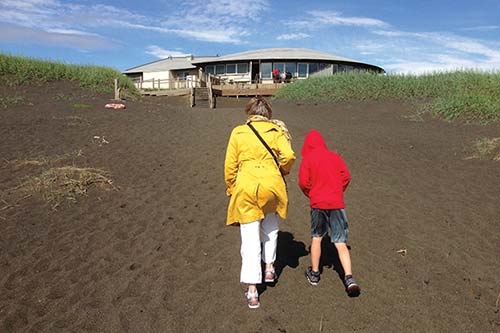
In Hveragerði: Consider dinner at the wonderful Ölverk pizzeria and microbrewery in Hveragerði (see the end of the Golden Circle chapter).
In Hafnarfjörður: An efficient, close-to-home option is to stop off in Hafnarfjörður for dinner on your way through Reykjavík’s suburban sprawl (see recommendations in that chapter).
For locations, see the map on here.
Near Hvolsvöllur: Named after the river it backs up to, $$$$ Hotel Rangá is a classic-feeling, high-end luxury resort with 51 woody, rustic, and unpretentious rooms and inviting, lodge-like public spaces. They also have an observatory and offer a “northern lights wake-up service” in case of any late-night light shows. You’ll also find a hot tub to relax in, a pricey restaurant, and a comfy bar with overstuffed leather chairs and reasonable prices. If you’re looking to splurge on the South Coast, this is the place (5 minutes west of Hvolsvöllur on highway 1 at Suðurlandsvegur, tel. 487-5700, www.hotelranga.is, hotelranga@hotelranga.is).
$$$ Hótel Selið (“Summer Pasture”), remote and restful, has eight modern rooms attached to a big red barn up a gravel road from highway 1, between Hella and Hvolsvöllur (about 15 minutes from either). Owner Hrafn (“Raven”) runs the place with pride and is generous with travel tips (simple dinners available for guests—book ahead, on road 264—watch for turnoff from highway 1 near Hotel Rangá, tel. 487-8790, www.hotelselid.is, selid@hotelselid.is).
Near Skógar: My favorite accommodation in this area, $$ Sólheimahjáleiga is a country-classy gem. This working farm—conscientiously run by the same family since 1875—is a tidy little compound with 300 sheep and 20 rooms split between new and old buildings. There’s a shared kitchen for guests to use, and dinner is available on request (cheaper rooms with shared bath, just off the main road between Skógar and Vík, tel. 864-2919, www.solheimahjaleiga.is, booking@solheimahjaleiga.is).
Near Hella: $$ Hótel Lækur (“Creek”) has 21 rooms filling a renovated old barn and a modern annex (full restaurant, 15-minute drive down a gravel road north of main highway connecting Hella and Hvolsvöllur, near village of Hróarslækur, tel. 466-3930, www.hotellaekur.is, laekur@hotellaekur.is).
$$ Álfasteinn Guesthouse is a sod-roofed country home that oozes atmosphere. The main house has several (cheaper) rooms with shared bath, and there are also two separate guest cottages with bath. Ágúst Rúnarsson—the well-traveled host—is a wealth of information who understands travelers’ needs and also guides mountain adventures (5.5 miles west of Hella—turn off at the Ásamýri sign, then take the first right, tel. 772-8304, www.icelandmagic.is, icelandmagic@icelandmagic.is).
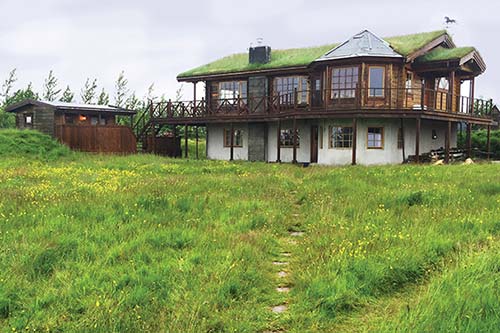
Big Chain Hotels: Along the South Coast, you’ll also find large, tour group-oriented hotels operated by big chains: $$$ Icelandair Hotel Vík (44 rooms, tel. 487-1480, www.icelandairhotels.com, info@icehotels.is) and $$ Fosshotel Hekla, just north of highway 1 between Hella and Selfoss (42 rooms, tel. 486-5540, www.fosshotel.is, bookings@fosshotel.is).
Þórsmörk (THORS-murk)—literally “Thor’s Woods”—is a rugged mountain valley immersed in a dramatic glacial landscape. This is one of Iceland’s premiere hiking destinations, with a well-marked network of trails that let you gain elevation for thrilling views over volcanoes, glaciers, and valleys.
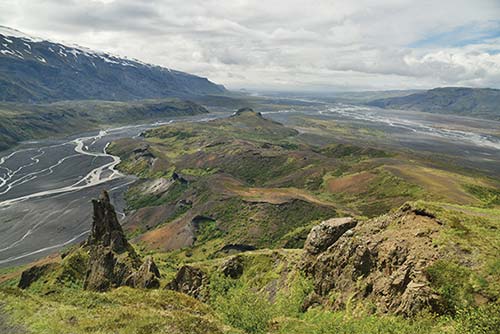
Þórsmörk is tucked in between three glacier-topped volcanoes: Eyjafjallajökull (the famous “E15”), Mýrdalsjökull (Iceland’s fourth-largest glacier), and the small Tindfjallajökull. It’s flanked by the wide Markárfljót river valley to the north, and the Krossá river valley to the south. The mountain ridge just south of the Krossá (near the Básar hut/bus stop) is called Goðaland (“Good Country”)—but in practice, the entire area is known as “Þórsmörk.”
For most visitors, half the fun of Þórsmörk is getting there: It’s accessible only on gravel roads that ford several rushing rivers and streams. While some intrepid drivers (with specially equipped 4x4s) attempt visiting Þórsmörk on their own, for the rest of us, jacked-up buses on monster-truck tires provide a memorable journey.
Þórsmörk requires the better part of a day, and most visitors do it as a long day trip from Reykjavík. The information here is designed to help travelers doing Þórsmörk in one busy day—with an emphasis on its most rewarding hike, to the stunning Valahnúkur viewpoint (with 360-degree panoramas). While not time-consuming, this hike is moderately challenging and very steep in parts. If you’re not physically up for the climb, you may want to skip Þórsmörk—although the bus ride in and out is fun, and the area is scenic, there’s not much for nonhikers to do.
By Car: To reach Þórsmörk, turn off highway 1 north on road 249, pass the Seljalandsfoss waterfall (buses stop here for a photo op), then continue north to where the road turns to gravel. From there, the route hooks east and goes under several streams as it works its way along—and eventually through the middle of—the Krossá river to Þórsmörk. Throughout its course, the river splinters and remerges, and the flow can vary dramatically; the drive into Þórsmörk is never the same twice.
Drivers who have a full-size 4x4 vehicle, and really know what they’re doing, can attempt Þórsmörk on their own—but before you do, check current conditions (www.safetravel.is), watch some YouTube videos to fully understand what you’re committing to, and be sure your car-rental company is OK with the idea.
By Bus: The one-way journey from Reykjavík to the Þórsmörk Volcano Huts takes up to five hours. Three companies run very expensive bus services to Þórsmörk (summer only): Iceland On Your Own (part of Reykjavík Excursions; 3/day June-Aug, 1/day in May and Sept, www.ioyo.is); Iceland by Bus (1/day late-June-early-Sept, www.icelandbybus.is); and Trex buses (2/day mid-June-late-Sept, www.trex.is). Buses begin in Reykjavík and make a few stops on their way to and from Þórsmörk. If you’re overnighting along the South Coast, you can catch the bus at the N1 gas station in Hvolsvöllur (about the halfway point on the bus ride). Figure around 15,000 ISK round-trip from Reykjavík. While you can theoretically just hop on the bus, it’s smart to book a day or two ahead (once you’re confident that the weather is good enough to justify the trip).
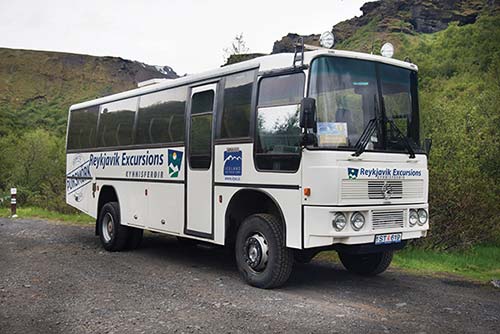
Stops Along the Way: On the way into Þórsmörk, most buses stop for a stretch-your-legs photo op at Gígjökull, a glacial tongue of Eyjafjallajökull. In the 2010 eruption, melted glacier water came pouring down Gígjökull, flooding this area and silting up what had been a dreamy glacier lagoon. You can also see a gigantic rock split cleanly in half—a reminder of the geological power at play here.
The primary bus stop is Húsadalur (also known as the Volcano Huts), facing the broad Markárfljót valley, with a little café, shop, and information point. It’s a popular launchpad for day hikes—the challenging Valahnúkur hike and the easier saddle hike to Langidalur both begin here.
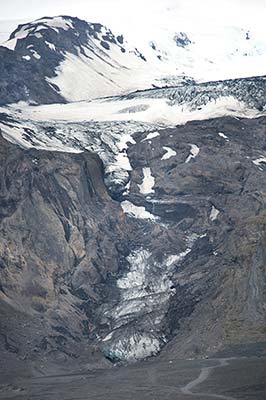
The other stops are in the narrower, adjacent Krossá valley: Stakkholtsgjá, a stop made by request only, is where you can hike up a scenic canyon. Langidalur, just over the ridge from Húsadalur, faces the Krossá valley and the Goðaland ridge. It’s home to the Skagfjörðsskáli hut, from where you can cross over Þórsmörk either on the steep Valahnúkur route, or on the easier saddle trail. The Básar/Goðaland hut is the end of the line, at the base of the Goðaland ridge, on the opposite side of the Krossá from Langidalur.
This section focuses on hikes for day-trippers. Those overnighting have many more options—get information at the various huts, and invest in a good hiking map (available at huts for 1,000-1,500 ISK). Þórsmörk is also a stop along several multiday hiking routes. Check trail conditions before heading out.
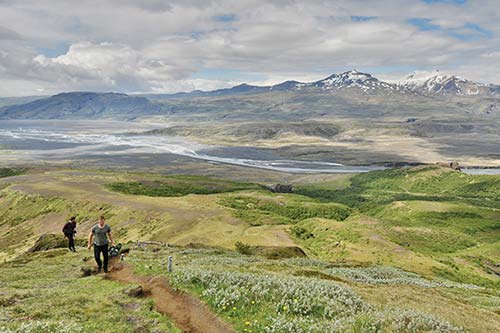
Hiking Options: Most people hop off the bus at Húsadalur, hike from the Volcano Huts over Valahnúkur, descend to Langidalur, then return on the easy saddle trail back to Húsadalur. With more time, consider riding the bus all the way to Básar, hiking across the Krossá to Langidalur, then summiting Valahnúkur and descending to Húsadalur for your return bus at the Volcano Huts; you’ll miss the wooded saddle hike, but the variety gained by hiking across the river valley more than makes up for it. Stakkholtsgjá is a fine hike, but bus schedules can make it hard to combine with others in the area. See below for more details on each of these options.
The main reason to come to Þórsmörk is for this glorious hike, offering stunning views in every direction. But the trail makes you earn it: While the hike isn’t long (less than one mile from either valley to the summit), it’s extremely steep in stretches (with an overall gain of 1,500 feet). The footing varies—stone steps, wooden steps, gravel—but it’s mostly stable. You can hike to Valahnúkur from the Volcano Huts (Húsadalur) or from Langidalur. Either way, follow the well-marked Valahnúkur trail up, up, up, enjoying higher and higher views. Near the summit, the ladder-like trail gets vertiginous, but keep going and take plenty of breaks.
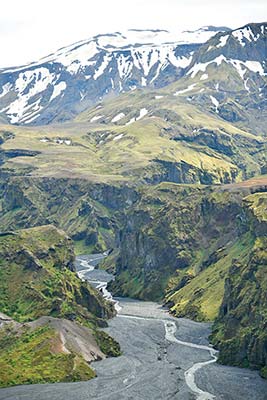
From the top, scan the horizon for the three glacier-topped volcanoes that surround Þórsmörk, the adjacent Goðaland range, and glacial valleys that fan out into the horizon. The smaller valley just to the right of the Krossá is the Hvanná. Look just above this, to the saddle of land between the two big glaciers (Eyjafjallajökull and Mýrdalsjökull); this is Fimmvörðuháls, where the first stage of the big 2010 Eyjafjallajökull eruption took place. On the steep trail back down, watch your footing and take your time. Figure about 1.5 hours to summit Valahnúkur and make it back down the other side.
The easiest ascent over the Þórsmörk ridge connects two low-lying valleys: Langidalur (“Long Valley”) and Húsadalur (“House Valley”). The terrain is pretty but mostly wooded, without dramatic views. Hikers use this trail mainly for an easy return to the Volcano Huts after tackling Valahnúkur, but it’s also a nice option for those seeking an easier hike (figure 45 minutes or less, one-way). Along the Húsadalur, among the jagged volcanic formations just above the Volcano Huts, a side-trail leads to Snorraríki—a cave burrowed into a wall that’s carved with modern names and old runic inscriptions (to reach the cave itself, you’ll need to scale a wall with stone footholds).
The Krossá river carves its way through a rocky landscape between Básar (at the base of the Goðaland ridge) and Langidalur (at the base of the Þórsmörk range). This is the same river you’ll crisscross on your way to and from this area, but the 30-minute hike across this valley gives you a closer look. As you walk across the desolate expanse, keep an eye out for two or three movable bridges, which are strategically placed to help hikers cross (marked with yellow arrows). The footing is uneven but walkable—a mix of sand, pebble, and ankle-twisting rock of every color.
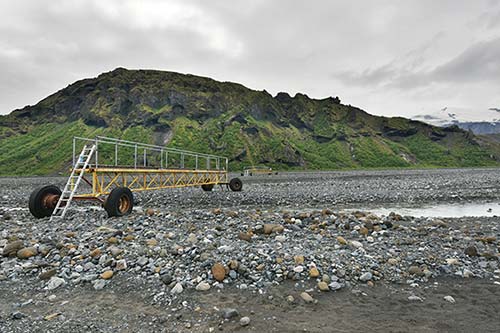
This narrow valley, with walls up to 300 feet high, cuts a mossy mile-and-a-quarter deep into the cliff. Plan on 1.5 hours round-trip for this hike. While mostly level, the footing is uneven, and the canyon’s river is always in flux—you’ll likely have to step, or even jump or wade, across a swift current (wear proper footwear). Where the stream forks, bear left. The ever-narrowing canyon culminates at a cave-like enclosure with a gushing waterfall. For a closer look, you’ll have to scramble up some slippery rocks. Unfortunately, this hike’s location—not easily walkable to the other trailheads—makes it tricky to combine with other hikes in the area. Stakkholtsgjá is a good compromise for reasonably hardy hikers who don’t mind uneven footing and want a scenic walk, but aren’t up for the steepness of Valahnúkur. Note that buses stop here by request only; before getting off, clearly establish the return bus time with your driver.
Serious hikers enjoy settling in for a few days to explore Þórsmörk. Your options are the ¢ Volcano Huts at Húsadalur, with a variety of private rooms, dorms, cottages, and camping (www.volcanohuts.com); the ¢ Skagfjörðsskáli hut, at Langidalur, with dorms, camping, and a private cottage (www.fi.is); and ¢ Básar, with dorms and camping across the valley from Skagfjörðsskáli in the Goðaland foothills (www.utivist.is).
Services are sparse in Þórsmörk. The only real restaurant is the $ cafeteria at the Volcano Huts. It’s smart to bring a picnic to enjoy at your leisure—there are plenty of glorious viewpoints.